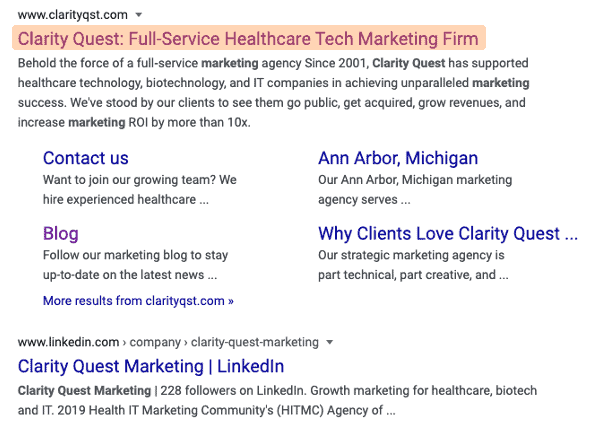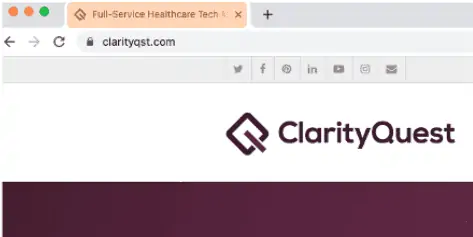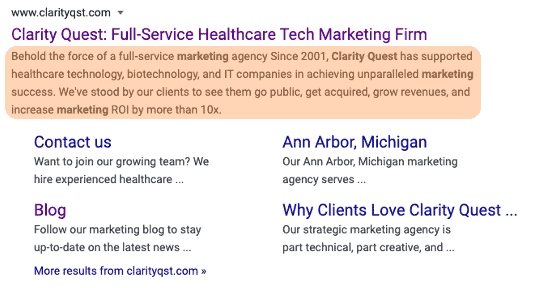Creating a brand new website or revamping an existing site is the perfect time to implement a solid search engine optimization strategy. Whether you have some experience with organic search optimization or are starting from scratch, a website design project is an ideal opportunity to get your SEO ducks in a row.
Once you’ve completed a comprehensive key phrase analysis (looking at search volumes, ranking difficulty, competitor rankings, etc.) and chosen your top key phrase targets, it’s time to write the website copy. In addition to writing copy that is compelling and informative, your website content should also be optimized for ranking in the organic search engine results.
Not sure how to start? Follow these best practices and tips from our award-winning healthcare technology marketing agency.
Website copywriting best practices for SEO
1. Match key phrase targets with webpages
As a rule of thumb, you can choose one distinct key phrase target per webpage. Be sure to choose a long-tail key phrase to help your page rank for other related terms. For pages with substantial amounts of text and content, you may be able to target two similar key phrases per page, if you get creative. Once you match a key phrase target to each page, you can move on to optimizing the most important on-page elements.
Tip: You won’t have much luck ranking a webpage that has minimal content. For example, a Contact Us page usually has little copy other than business contact information. This is not a good webpage to optimize for SEO, unless you are trying to rank in a specific geographic area. Instead, focus on assigning key phrase targets to webpages that have a few paragraphs of copy, images, videos, and other content, and optimize accordingly.
2. Optimize title tags
The title tag is one of the most important on-page elements to optimize for SEO. The recommended character limit for title tags is anywhere from 55-70 characters. The real length is measured in pixels, so free SEO plug-ins are handy to tell you at-a-glance if your title tags are within the acceptable range.
Be sure to abide by this rule. If your title tag is too long, the search engines will truncate it in the search results, which can harm the searcher experience. If the searcher can only see the first 55 characters of your title tag in the search results page, will they be able to understand what your page is about? If not, you may lose out on the click.
Keep in mind that search engines can change your title tag on the results pages at their will. Stick to the character limits for the best chance at displaying your desired title tag.

Clarity Quest’s homepage title tag displayed in the Google organic search results, highlighted in light orange.

Clarity Quest’s homepage title tag displayed in the Chrome browser tab, highlighted in light orange.
Tip: Include your company name or brand name at the end of your title tag, preceded by a vertical bar. Keep this branding element short to leave more room for your key phrase targets.
3. Leverage meta descriptions
While Google no longer considers them as an organic ranking signal, meta descriptions are given prime real estate on the organic search result pages. Take advantage of this opportunity by writing an intriguing sentence or two that entices searchers to click through to your webpage. This is your chance to earn the click. Keep it to 140 characters maximum.

Clarity Quest’s homepage meta description displayed in the Google organic search results, highlighted in light orange.
Tip: It is not required to use a key phrase target in the meta description, but keep in mind that search engines bold the words in the search results that match the searcher’s query. So if someone searches for your key phrase, it will be bolded wherever it appears in your meta description, title tag, and page URL, helping to grab attention and clicks.
4. Use proper header tag hierarchy
Another important area for on-page search engine optimization is the H1 header tag. The H1 is the most prominent header on your webpage, and typically is the first item below the top navigation and banner. In some designs, the H1 header can be in the banner itself.
The H1 gives search engines more information to help them categorize your webpage. Always include a variation of a key phrase target in the H1 if you can.

Clarity Quest’s homepage H1 header, highlighted in light orange.
Tip: Proper header tag hierarchy can also help search engines navigate the content on your webpages. Use an H2 header for sub-sections of content within the H1 header section. Use an H3 header for sub-sections of content within the H2 header section. And so on.
5. Include key phrases in body copy
In addition to strategically placed key phrases in your title tags, meta descriptions, and page headers, search engines also look for key phrases within the body copy of each page. Include your key phrase target multiple times on your webpage for best results.
Tip: Key phrases should fit naturally within the text. Don’t try to stuff key phrases where they don’t belong. If it seems forced, try to rework the copy or consider adding your key phrase in another location where it sounds more authentic.
Users will pick up on unnatural language, which can negatively impact user experience. And search engines will pick up on too many mentions of a key phrase on one page, which can negatively impact organic rankings.
6. Write original copy for each page
Do not copy large chunks of text from other webpages on your site or from other websites, even if you own them. When search engines find two or more webpages with the same or very similar content, they will choose only one page to serve in the organic rankings and ignore the other.
Tip: If you do have two pages with identical content, use the rel=canonical tag to tell search engines which page you want them to index.
Bonus tip: Be sure to leverage your key phrase targets as anchor text links to other pages for further SEO and visitor navigability.
Need copywriting for SEO?
On-page optimization is just one of the important factors in achieving outstanding organic search rankings and earning inbound website traffic. The process starts with strategic key phrase research and analysis, and must be supported with high-quality website design, an intelligent content marketing strategy, and ongoing link building, content syndication, and outreach campaigns.
Contact us for more info on SEO and online marketing.
Note: This post was originally published in 2022 and has been updated to reflect updated best practices.


